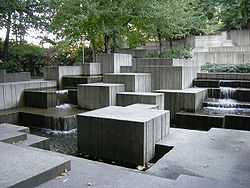Step-stone bridge
|
A rustic Step-Stone Bridge across a stream. | |
| Ancestor | None, this is one of the few foundational types, but see also: ford (crossing). |
|---|---|
| Related | Natural Stepping Stone stream crossing |
| Descendant | Clapper bridge, Zig-zag bridge, Log bridge |
| Carries | Pedestrians |
| Span range | Has no spans, but stones must be spaced to allow water flow and a comfortable step or leap |
| Material | Selected stone |
| Movable | No |
| Design effort | Low-rustic to Artisan applied art design |
| Falsework required | No |
A step-stone bridge or stepping stones is a simple bridge or causeway that allows a pedestrian to cross a natural watercourse or pond, or a garden's water feature where water is allowed to course between stone steps.[1] Unlike other bridges, they have no spans. Step-stone bridges, along with log bridges, are likely to be the oldest bridge types. They are often built by hikers and disarranged during periods of high, fast water.
Historic step-stone bridge
The Drukken Steps in the Eglinton Woods of North Ayrshire in Scotland were a favourite haunt of the renowned poet Robert Burns and his companion Richard Brown, whilst the two were living in Irvine from 1781 to 1782.[2]
The name "Drukken" steps derives from a person's gait as they stepped from stone to stone whilst crossing the Red Burn. Seven or more stones were originally set in the Red Burn which was much wider than now (2009).[3]
Burns himself used the Scots spelling "Drucken" rather than "Drukken".[4] The ruins of the Drukken Steps are now found in the Eglinton Country Park.
Gallery
-

A step-stone bridge crossing the "dry landscape pond" of Taisan-ji, Kobe, Japan.
-

Freeway Park-Downtown Seattle-Washington (U.S. state)
-

Freeway Park-Downtown Seattle-Washington (U.S. state)
-

The stepping stones in the Rothay, Lake District, England.
See also
| Wikimedia Commons has media related to Step-stone bridges. |
- Clapper bridge
- Footbridge
- Ford (crossing)
- Kulgrinda
References
- ↑ "Glossary of Trail and Greenway Terms". South Carolina State Trails Program. 2008. Retrieved 5 January 2014.
- ↑ Love, page 60.
- ↑ King.
- ↑ Scotch Drink
